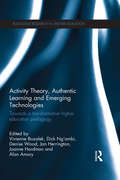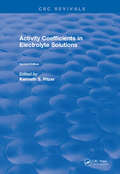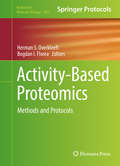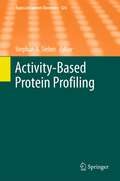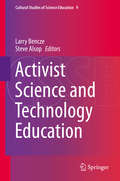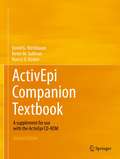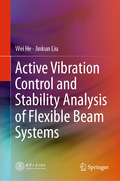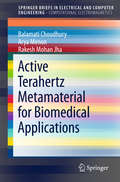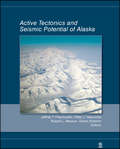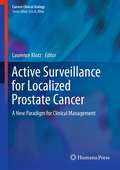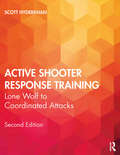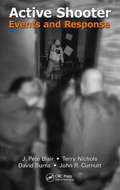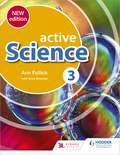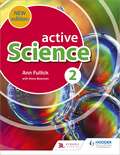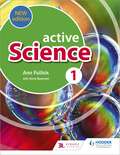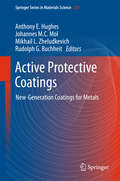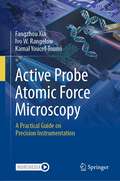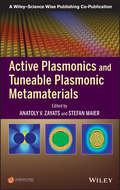- Table View
- List View
Activity Theory, Authentic Learning and Emerging Technologies: Towards a transformative higher education pedagogy (Routledge Research in Higher Education)
by Denise Wood Vivienne Bozalek Dick Ng’ambi Jan Herrington Joanne Hardman Alan AmoryAlthough emerging technologies are becoming popularised for teaching, learning and research, the relationship between their use and transformative effects on higher education remain largely unexplored. This edited collection seeks to fill this gap by providing a nuanced view, locating higher education pedagogical practices at an intersection of emerging technologies, authentic learning and activity systems. Providing numerous case studies as examples, the book draws from a wide range of contexts to illustrate how such a convergence has the potential to track transformative teaching and learning practices in the higher education sector. Chapters provide the reader with a variety of transformative higher education pedagogical practices in southern contexts, theorised within the framework of Cultural Historical Activity Theory (CHAT) and tool mediation, while using authentic learning as a pedagogical model upon which this theoretical framework is based. The topics covered in the book have global relevance, with research paying particular attention to South Africa, Australia and New Zealand, where the authors are based. The book will be of interest to educators, researchers and practitioners in higher education, as well as those interested in emerging technologies in education more generally.
Activity Coefficients in Electrolyte Solutions
by Kenneth S. PitzerThis book was first published in 1991. It considers the concepts and theories relating to mostly aqueous systems of activity coefficients.
Activity-Based Proteomics: 9781493964376 (Methods in Molecular Biology #1491)
by Herman S. Overkleeft Bogdan I. FloreaThis volume focuses on explorative activity-based proteomics, biomedical applications of activity-based proteomics, and chemical strategies in activity-based proteomics providing a concise overview of activity-based protein profiling. Written in the highly successful Methods in Molecular Biology series format, chapters include introductions to their respective topics, lists of the necessary materials and reagents, step-by-step, readily reproducible laboratory protocols, and tips on troubleshooting and avoiding known pitfalls.
Activity-Based Protein Profiling (Topics in Current Chemistry #324)
by Stephan A. SieberABPP Methodology: Introduction and Overview, by Matthew B. Nodwell und Stephan A. Sieber Activity-Based Protein Profiling for Natural Product Target Discovery, by Joanna Krysiak und Rolf Breinbauer Photoaffinity Labeling in Activity-Based Protein Profiling, by Paul P. Geurink, Laurette M. Prely, Gijs A. van der Marel, Rainer Bischoff und Herman S. Overkleeft Application of Activity-Based Protein Profiling to the Study of Microbial Pathogenesis, by William P. Heal und Edward W. Tate Functional Analysis of Protein Targets by Metabolomic Approaches, by Yun-Gon Kim und Alan Saghatelian
Activist Science and Technology Education (Cultural Studies of Science Education #9)
by Larry Bencze Steve AlsopThis collection examines issues of agency, power, politics and identity as they relate to science and technology and education, within contemporary settings. Social, economic and ecological critique and reform are examined by numerous contributing authors, from a range of international contexts. These chapters examine pressing pedagogical questions within socio-scientific contexts, including petroleum economies, food justice, health, environmentalism, climate change, social media and biotechnologies. Readers will discover far reaching inquiries into activism as an open question for science and technology education, citizenship and democracy. The authors call on the work of prominent scholars throughout the ages, including Bourdieu, Foucault, Giroux, Jasanoff, Kierkegaard, Marx, Nietzsche, Rancière and Žižek. The application of critical theoretical scholarship to mainstream practices in science and technology education distinguishes this book, and this deep, theoretical treatment is complemented by many grounded, more pragmatic exemplars of activist pedagogies. Practical examples are set within the public sphere, within selected new social movements, and also within more formal institutional settings, including elementary and secondary schools, and higher education. These assembled discussions provide a basis for a more radically reflexive reworking of science and technology education. Educational policy makers, science education scholars, and science and technology educators, amongst others, will find this work thought-provoking, instructive and informative.
ActivEpi Companion Textbook: A supplement for use with the ActivEpi CD-ROM
by David G. Kleinbaum Kevin M. Sullivan Nancy D. BarkerThis Companion Textbook supplements the ActivEpi CD-ROM, sold separately. The ActivEpi CD-ROM provides a multimedia presentation of concepts, commonly taught in an introductory epidemiology course. ActivEpi mixes a full array of media to motivate, explain, visualize and apply epidemiological concepts. Virtually all of the material on the ActivEpi CD-ROM is included in the Companion Textbook. Because individuals differ in their learning skills, the ActivEpi CD-ROM and the ActivEpi Companion Textbook offer readers different but related options on how to learn epidemiology. The Textbook can be used as a hardcopy reference of the textual materials contained on the CD-ROM, as a resource for the practice exercises, as a general reference, or even a self-contained textbook. ActivEpi includes 15 lessons and over 50 hours of content via more than 250 launchable activities and homework exercises. It can be used in a variety of teaching formats: distance learning, self-paced learning, on-campus courses, and short courses. For the latest additions to ActivEpi, visit David Kleinbaum's website.
Active Vibration Control and Stability Analysis of Flexible Beam Systems
by Wei He Jinkun LiuThis book presents theoretical explorations of several fundamental problems in the dynamics and control of flexible beam systems. By integrating fresh concepts and results to form a systematic approach to control, it establishes a basic theoretical framework. It includes typical control design examples verified using MATLAB simulation, which in turn illustrate the successful practical applications of active vibration control theory for flexible beam systems. The book is primarily intended for researchers and engineers in the control system and mechanical engineering community, offering them a unique resource.
Active Terahertz Metamaterial for Biomedical Applications (SpringerBriefs in Electrical and Computer Engineering)
by Rakesh Mohan Jha Balamati Choudhury Arya MenonThis book describes a metamaterial-based active absorber for potential biomedical engineering applications. Terahertz (THz) spectroscopy is an important tool for imaging in the field of biomedical engineering, due to the non-invasive, non-ionizing nature of terahertz radiation coupled with its propagation characteristics in water, which allows the operator to obtain high-contrast images of skin cancers, burns, etc. without detrimental effects. In order to tap this huge potential, it is important to build highly efficient biomedical imaging systems by introducing terahertz absorbers into biomedical detectors. The biggest challenge faced in the fulfilment of this objective is the lack of naturally occurring dielectrics, which is overcome with the use of artificially engineered resonant materials, viz. metamaterials. This book describes such a metamaterial-based active absorber. The design has been optimized using particle swarm optimization (PSO), eventually resulting in an ultra-thin active terahertz absorber. The absorber shows near unity absorption for a tuning range of terahertz (THz) application.
Active Tectonics and Seismic Potential of Alaska
by Göran Ekström Robert L. Wesson Peter J. Haeussler Jeffrey T. FreymuellerPublished by the American Geophysical Union as part of the Geophysical Monograph Series, Volume 179. This multidisciplinary monograph provides the first modern integrative summary focused on the most spectacular active tectonic systems in North America. Encompassing seismology, tectonics, geology, and geodesy, it includes papers that summarize the state of knowledge, including background material for those unfamiliar with the region; address global hypotheses using data from Alaska; and test important global hypotheses using data from this region. It is organized around four major themes: subduction and great earthquakes at the Aleutian Arc, the transition from strike slip to accretion and subduction of the Yakutat microplate, the Denali fault and related structures and their role in accommodating permanent deformation of the overriding plate, and regional integration and large-scale models and the use of data from Alaska to address important global questions and hypotheses. The book's publication near the beginning of the National Science Foundation's EarthScope project makes it especially timely because Alaska is perhaps the least understood area within the EarthScope footprint, and interest in the region can be expected to rise with time as more EarthScope data become available.
Active Surveillance for Localized Prostate Cancer: A New Paradigm for Clinical Management (Current Clinical Urology)
by Laurence KlotzActive Surveillance for Localized Prostate Cancer: A New Paradigm for Clinical Management will serve as a useful resource for physicians dealing with, and interested in, this complex and evolving branch of prostate cancer management. The book will also be of interest to scientifically literate patients and their families. The volume provides an introduction to the concept of active surveillance in oncology in general and prostate cancer specifically. The primary focus is to provide a comprehensive guide to the management of patients on surveillance. The volume covers the many complexities and nuances to this approach including, patient selection, risk assessment, how to overcome 'cancer hysteria' when counseling patients, identifying appropriate triggers for intervention, use of PSA kinetics and MR imaging information, technique and frequency of biopsies, secondary prevention interventions, and the relative roles of surveillance and focal therapy.
Active Shooter Response Training: Lone Wolf to Coordinated Attacks
by Scott HyderkhanActive Shooter Response Training: Lone Wolf to Coordinated Attack, Second Edition, provides expanded and updated training for police and security officers who must respond to an active shooter situation. This manual addresses all facets of preparation and response, from complex logistical organization to collective and individual tactics, as well as special units or special skills tasks. Based on time-tested military training doctrine, the program described here offers a template for agencies of all sizes to offer training that effectively utilizes officers’ available time. Hyderkhan and his expert contributors cover all aspects of the active shooter response (ASR) mission, from risk analysis to logistical planning for mass casualty events. He also addresses medical care and evacuation, reunification procedures, and post-incident investigation. Active Shooter Response Training, Second Edition, provides the tools needed to prevent or mitigate tragedy in our religious congregations, schools, and public places. The book includes a voucher code for a 50% discount off of the companion online library of training videos This book is directed to law enforcement agencies, private security teams, training organizations, police leaders, and individual officers and trainers, in the US and globally. It also has potential as recommended reading in policing courses at the community college and university level.
Active Shooter Events and Response
by John P. Blair Terry Nichols David Burns John R. CurnuttThe Columbine tragedy on April 20, 1999 began a new era in law enforcement as it became apparent that the police response to such mass shootings must be drastically altered. By the time the Sandy Hook Elementary School shooting occurred on December 14, 2012, outdated police response strategies had been replaced with new, aggressive tactics used by
Active Science 3 new edition
by Ann FullickBuild and assess your students' Science knowledge, understanding and skills through better learning techniques, ensuring a solid foundation for further science study.- Confidently meet the requirements of the Trinidad & Tobago, Barbados, Guyana and OECS curricula and CXC's CCSLC syllabus with detailed mapping grids available for free online. - Inspire students to progress with this contemporary take on Science that includes topics such as environmental science and green issues.- Engage students through an active learning approach with hands-on activities to promote learning through practice.- Prepare students for moving up to CSEC® level science with activities developed to bridge the gap between lower secondary and CSEC® level.
Active Science 3 new edition (Active Science #3)
by Ann FullickBuild and assess your students' Science knowledge, understanding and skills through better learning techniques, ensuring a solid foundation for further science study.- Confidently meet the requirements of the Trinidad & Tobago, Barbados, Guyana and OECS curricula and CXC's CCSLC syllabus with detailed mapping grids available for free online. - Inspire students to progress with this contemporary take on Science that includes topics such as environmental science and green issues.- Engage students through an active learning approach with hands-on activities to promote learning through practice.- Prepare students for moving up to CSEC® level science with activities developed to bridge the gap between lower secondary and CSEC® level.
Active Science 2 new edition (Active Science Ser.)
by Ann FullickBuild and assess your students' Science knowledge, understanding and skills through better learning techniques, ensuring a solid foundation for further science study.- Confidently meet the requirements of the Trinidad & Tobago, Barbados, Guyana and OECS curricula and CXC's CCSLC syllabus with detailed mapping grids available for free online. - Inspire students to progress with this contemporary take on Science that includes topics such as environmental science and green issues.- Engage students through an active learning approach with hands-on activities to promote learning through practice.- Prepare students for moving up to CSEC® level science with activities developed to bridge the gap between lower secondary and CSEC® level.
Active Science 2 new edition (Active Science #2)
by Ann FullickBuild and assess your students' Science knowledge, understanding and skills through better learning techniques, ensuring a solid foundation for further science study.- Confidently meet the requirements of the Trinidad & Tobago, Barbados, Guyana and OECS curricula and CXC's CCSLC syllabus with detailed mapping grids available for free online. - Inspire students to progress with this contemporary take on Science that includes topics such as environmental science and green issues.- Engage students through an active learning approach with hands-on activities to promote learning through practice.- Prepare students for moving up to CSEC® level science with activities developed to bridge the gap between lower secondary and CSEC® level.
Active Science 1 new edition (Active Science Ser.)
by Ann FullickBuild and assess your students' Science knowledge, understanding and skills through better learning techniques, ensuring a solid foundation for further science study.- Confidently meet the requirements of the Trinidad & Tobago, Barbados, Guyana and OECS curricula and CXC's CCSLC syllabus with detailed mapping grids available for free online. - Inspire students to progress with this contemporary take on Science that includes topics such as environmental science and green issues.- Engage students through an active learning approach with hands-on activities to promote learning through practice.- Prepare students for moving up to CSEC® level science with activities developed to bridge the gap between lower secondary and CSEC® level.
Active Science 1 new edition (Active Science #1)
by Ann FullickBuild and assess your students' Science knowledge, understanding and skills through better learning techniques, ensuring a solid foundation for further science study.- Confidently meet the requirements of the Trinidad & Tobago, Barbados, Guyana and OECS curricula and CXC's CCSLC syllabus with detailed mapping grids available for free online. - Inspire students to progress with this contemporary take on Science that includes topics such as environmental science and green issues.- Engage students through an active learning approach with hands-on activities to promote learning through practice.- Prepare students for moving up to CSEC® level science with activities developed to bridge the gap between lower secondary and CSEC® level.
Active Protective Coatings: New-Generation Coatings for Metals (Springer Series in Materials Science #233)
by Anthony E. Hughes Johannes M.C. Mol Mikhail L. Zheludkevich Rudolph G. BuchheitThis book coversa broad range of materials science that has been brought to bear on providingsolutions to the challenges of developing self-healing and protective coatingsfor a range of metals. The book has a strong emphasis on characterisationtechniques, particularly new techniques that are beginning to be used in thecoatings area. It features many contributions written by experts from variousindustrial sectors which examine the needs of the sectors and the state of theart. The developmentof self-healing and protective coatings has been an expanding field in recentyears and applies a lot of new knowledge gained from other fields as well asother areas of materials science to the development of coatings. It hasborrowed from fields such as the food and pharmaceutical industries who haveused, polymer techniques, sol-gel science and colloidosome technology for arange encapsulation techniques. It has also borrowed from fields like hydrogenstorage such as from the development of hierarchical and other materials basedon organic templating as "nanocontainers" for the delivery of inhibitors. Inmaterials science, recent developments in high throughput and othercharacterisation techniques, such as those available from synchrotrons, arebeing increasing used for novel characterisation - one only needs to look atthe application of these techniques in self healing polymers to gauge wealth ofnew information that has been gained from these techniques. This work islargely driven by the need to replace environmental pollutants and hazardouschemicals that represent risk to humans such as chromate inhibitors which arestill used in some applications.
Active Probe Atomic Force Microscopy: A Practical Guide on Precision Instrumentation
by Fangzhou Xia Ivo W. Rangelow Kamal Youcef-ToumiFrom a perspective of precision instrumentation, this book provides a guided tour to readers on exploring the inner workings of atomic force microscopy (AFM). Centered around AFM, a broad range of mechatronic system topics are covered including mechanics, sensors, actuators, transmission design, system identification, signal processing, dynamic system modeling, controller. With a solid theoretical foundation, practical examples are provided for AFM subsystem level design on nano-positioning system, cantilever probe, control system and system integration. This book emphasizes novel development of active cantilever probes with embedded transducers, which enables new AFM capabilities for advanced applications. Full design details of a low-cost educational AFM and a Scale Model Interactive Learning Extended Reality (SMILER) toolkit are provided, which helps instructors to make use of this book for curriculum development. This book aims to empower AFM users with deeper understanding of the instrument to extend AFM functionalities for advanced state-of-the-art research studies. Going beyond AFM, materials presented in this book are widely applicable to precision mechatronic system design covered in many upper-level graduate courses in mechanical and electrical engineering to cultivate next generation instrumentalists.
Active Plasmonics and Tuneable Plasmonic Metamaterials
by Anatoly V. Zayats Stefan A. MaierThis book, edited by two of the most respected researchers in plasmonics, gives an overview of the current state in plasmonics and plasmonic-based metamaterials, with an emphasis on active functionalities and an eye to future developments. This book is multifunctional, useful for newcomers and scientists interested in applications of plasmonics and metamaterials as well as for established researchers in this multidisciplinary area.
Active Physics Sports
by Arthur Eisenkraft Howard Brody Mary Quinlan Carl Duzen David Wright Jon L. HarknessAll student activities in this textbook have been designed to be as safe as possible, and have been reviewed by professionals specifically for that purpose. As well, appropriate warnings concerning potential safety hazards are included where applicable to particular activities.
